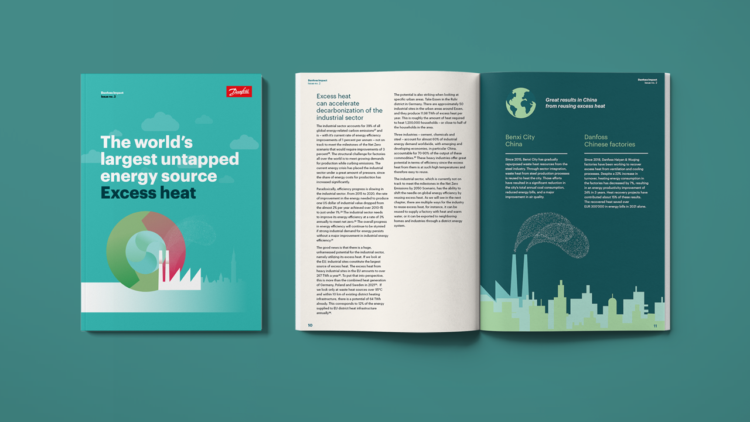Calls it world’s largest untapped source of energy
NORDBORG, Denmark, 22 February 2023: According to new data, excess heat in the EU alone amounts to 2,860 TWh/y, corresponding almost to the EU’s total energy demand for heat and hot water in residential and service sector buildings, including schools, hospitals, hotels, restaurants and shopping centres, Danfoss said through a Press release, on the occasion of releasing a whitepaper on the subject, titled ‘The world’s largest untapped energy source: Excess heat’.
Kim Fausing, President & CEO, Danfoss, said, “It is remarkable that the EU has “close to no initiatives that push for more efficient use of the vast amounts of wasted energy in the form of excess heat.” The whitepaper explained that tapping into the excess heat would give a productivity boost to the economy, lower energy prices for consumers and businesses and accelerate the green transition.
According to Danfoss, a full implementation of technologies that tap into synergies between different sectors and enable a utilisation of excess heat has the potential to save EUR 67.4 bn a year, once fully implemented in 2050.
Every time an engine runs, it generates heat, Danfoss pointed out. Anyone who has felt the warmth behind their fridge can confirm this. The same is true on a larger scale in supermarkets, data centres, factories, wastewater facilities, metro stations and commercial buildings. Excess heat can be reused to supply a factory with heat and warm water or reused by neighboring homes and industries through a district energy system, Danfoss said.

Using this energy that would otherwise go to waste can give a productivity boost to the economy and lower energy prices for consumers, Danfoss said. Utilising excess heat can replace significant amounts of fossil fuels that are otherwise needed to produce heat. Used this way, excess heat can help stabilise the future electricity grid and, thereby, ease the transition to a green energy system, Danfoss said.
In some countries, the excess heat can even match the entire heat demand, Danfoss said. In the Netherlands, excess heat amounts to 156 TWh/y, while the heat demand is only 152 TWh/y, Danfoss added.
Yet the potential of excess heat is not even close to being utilised and is politically ignored, Danfoss said.
Fausing said recycling heat is not only an overlooked measure in the current energy crisis, but also the next frontier of the green transition. “Excess heat is the world’s largest untapped source of energy,” he said. “Still, very few initiatives have pushed for more efficient use of the vast amounts of wasted energy in the form of excess heat, even though we already have the solutions available today. We urgently need policy measures to accelerate the use of excess heat across sectors, both so that citizens and businesses can benefit from lower energy costs and to ensure we step up progress in the green transition.
“Energy demand is set to grow dramatically in the years to come due to population growth and rising incomes. Without urgent action to tackle the demand side of the green equation, using every single unit of energy more efficiently, we will not get on track to meet global climate goals.”
The whitepaper assesses the potential of excess heat as an efficient energy source, Danfoss said. Quoting the International Energy Agency (IEA), Danfoss said a global push for more efficient use of energy can reduce CO2 emissions by an additional five gigatons per year by 2030, compared with current policy settings. A third of the reduction needed in energy-related CO2 emissions this decade, according to the IEA net-zero scenario, must come from improvements in energy efficiency, Danfoss said.
In terms of energy security, these energy savings can help avoid almost 30 million barrels of oil per day and 650 billion cubic metres (bcm) of natural gas per year (around four times what the EU imported from Russia in 2021), Danfoss said.
Fausing said: “The potential in reusing excess heat is staggering. But we need to change our perspective on it and begin to consider excess heat as an energy resource instead of waste to be disposed of.
“Today there are a number of barriers that prevent us from reusing excess heat, including lack of information and regulation. We have to introduce economic incentives, policy measures and prioritisation of partnerships between local authorities, energy suppliers and energy sources to help maximize the full potential of excess heat.”
Toby Morgan, Senior Manager, Built Environment, Climate Group, commenting on the potential for excess heat, said: “The global energy crisis is a wakeup call to stop wasting energy, and Danfoss is right to call for governments and corporates to seize the enormous potential of excess heat. Now, more than ever, we need to make better use of the energy we already produce; we simply can’t afford to let it literally escape out the window. Energy efficiency improvements, like capturing and recycling excess heat, are absolutely critical to lower fossil fuel demand and lower bills.”
According to Danfoss, ‘The world’s largest untapped energy source: Excess heat’ is available for download here.
Copyright © 2006-2025 - CPI Industry. All rights reserved.